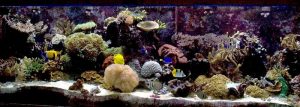I just finished a too long needed maintenance on my reef tank. It was getting to the point where there was so much coralline algae growing on the front pane that visibility was seriously compromised, and to make matters worse I was unable to enjoy looking at my captive critters. My reef tank was fast becoming an unweeded garden so to speak. I also knew that I would have to spend the good part of a day, and didn’t really want to. I’m sure that many reef keepers out there have had similar feelings. Sometimes it seems to me that I have spent a good part of my life doing tank maintenance, and for almost 60-years.
First, I had to empty the canister that holds my activated carbon and “Phosguard.” Once cleaned out I added a layer of new carbon, followed by a layer of Phosguardtm, and that followed by another layer of carbon. With that back on line I turned to my two large skimmers, where even though the skimmate is collected in external canisters, the inner walls of both skimmers had about 3/8 of an inch of muck clinging to them. Using a plastic spatula I collected about a gallon of this muck/detritus, which I then saved for use as fertilizer for my terrestrial plants. I, at this time, checked the ozonizer, which I use to inject ozone into one of the skimmers. With the skimmers cleaned they were put back on line. Incidentally, these two skimmers process about 4,000-GPH.
Next comes the coral gardening; that is, trying to keep various animals from stinging one another as they grow. There was a time when I was thrilled to see Acroporas grow, but now I’d like to slow their growth down. Fortunately, I no longer have to concern myself with invasive anemones, like Manjano sp. and Aiptasias. My double saddle back butterfly (C. ulietensis.) has completely eliminated them. I have heard from a reef keeper who insists that the butterfly that I have is really a C. Falcula. These fish look a great deal alike so I’m not sure who is correct. In fact, they could be morphs of the same species.
Finally comes the part that I really dislike: cleaning coralline algae off of the 8×3-foot acrylic front pane. Over the last few years I have constructed various tools that will both remove the algae but not scratch the plastic. It does take several hours – even with my various gadgets – and usually I manage to add a few new scratches despite my best efforts. A company called EverClear has send me equipment to remove these inevitable scratches. I do plan on writing up a review of this well made equipment. So far, I have used their stuff on the outside with great success, but the real test will come when I try to remove the ones inside, under water.
Finally, it’s all done, and I can step back and really enjoy the tank again. Slowly, all of the fish come out from hiding and life in my captive reef returns to normal. In fact, it looks so good I grab my camera and take some new pictures, which are shown here. The numbers on one of the pictures tells how long that particular animal has been with me.














0 Comments